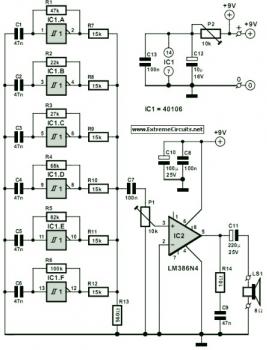This is the circuit diagram of steam whistle sound generator. This circuit contains six square wave oscillators. Square waves are composed of a huge variety of harmonics. If six square waves with various frequencies are added collectively, the final result is going to be a signal which has a very large number of frequencies. When you listen to the result you will find out that it happens to be very identical to a steam whistle sound. The circuit ought to be beneficial in modelling or even in a sound studio. This circuit works by using only two ICs. The first IC, a 40106, consists of six Schmitt triggers, that are all set up as oscillators. Various frequencies are produced from the utilization of various feedback resistors.
The output signals from the Schmitt triggers are mixed via resistors. The resulting signal is amplified by IC2, an LM386. This IC can deliver audio power of about 1 W , which should be enough for driving the loudspeaker for most sound related electronic circuit. In case you leave out R13 and all parts after P1, the output can then be connected to a more strong amplifier. In this way a definitely deafening steam whistle could be made. The ‘frequency’ of the signal could be altered with P2, and P1 is used to control the volume.
Steam whistle sound generator circuit source: extremecircuits.net
About Audio Amplifier
An audio amplifier is an electronic amplifier that amplifies low-power audio signals (signals composed primarily of frequencies between 20 - 20 000 Hz, the human range of hearing) to a level suitable for driving loudspeakers and is the final stage in a typical audio playback chain.
The preceding stages in such a chain are low power audio amplifiers which perform tasks like pre-amplification, equalization, tone control, mixing/effects, or audio sources like record players, CD players, and cassette players. Most audio amplifiers require these low-level inputs to adhere to line levels.
While the input signal to an audio amplifier may measure only a few hundred microwatts, its output may be tens, hundreds, or thousands of watts. More explanation about power audio amplifier can be found at wikipedia.org
An audio amplifier is an electronic amplifier that amplifies low-power audio signals (signals composed primarily of frequencies between 20 - 20 000 Hz, the human range of hearing) to a level suitable for driving loudspeakers and is the final stage in a typical audio playback chain.
The preceding stages in such a chain are low power audio amplifiers which perform tasks like pre-amplification, equalization, tone control, mixing/effects, or audio sources like record players, CD players, and cassette players. Most audio amplifiers require these low-level inputs to adhere to line levels.
While the input signal to an audio amplifier may measure only a few hundred microwatts, its output may be tens, hundreds, or thousands of watts. More explanation about power audio amplifier can be found at wikipedia.org
This is a video tutorial about how to a very simple audio amplifier based on the LM386 amplifier chip. It can be built for less than $20 (or might be less than $8 in some countries) and used to amplify any low level audio signal including a guitar, bass or mp3 player.
Watch the video:

No comments:
Post a Comment